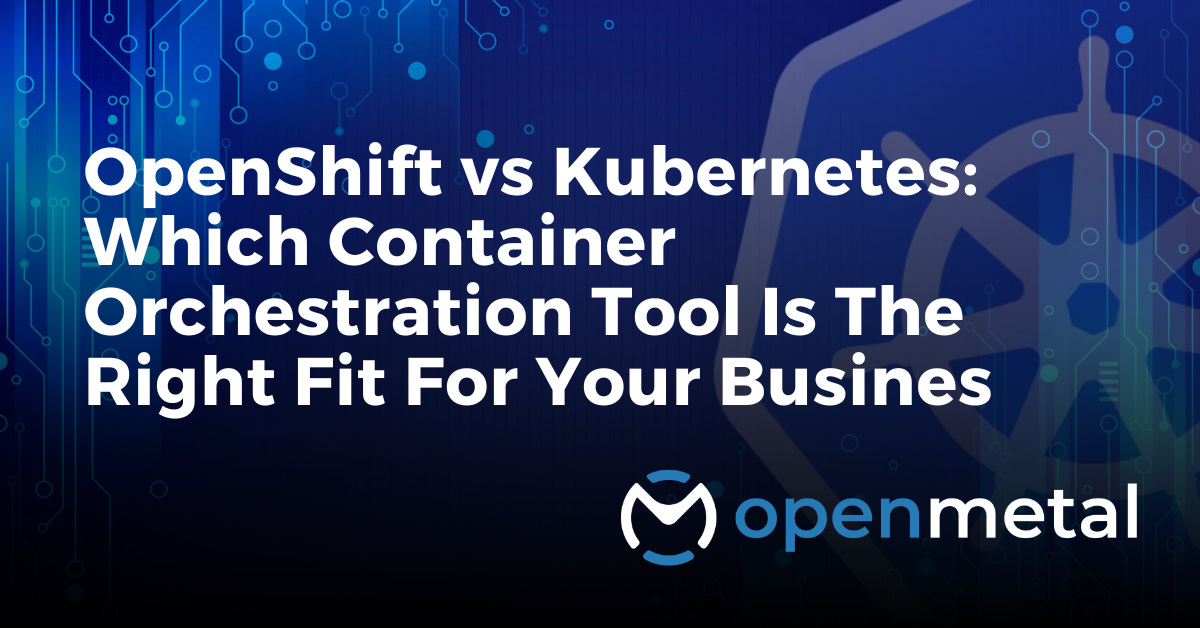OpenShift and Kubernetes are popular software used for container orchestration. To put it differently, Kubernetes and OpenShift are employed to manage and automate the deployment, scaling, and administration of containerized applications. They are both popular platforms for deploying cloud-native applications, and other modern applications that are designed to run in containerized environments.
In this blog post, we will begin by examining each software independently, and then we will proceed to compare and contrast them in detail. Lastly, we will delve into the factors that businesses should consider when making a decision between OpenShift and Kubernetes.
What is Kubernetes?
Kubernetes also known as K8s is an open-source platform that automates the management of applications through containers. Kubernetes is used to deploy containerized applications with self-healing, automation, high-availability, and dynamic deployments. Many of Kubernetes features are specifically designed to support and empower you to deliver dynamic, scalable, highly available services quickly and efficiently. Kubernetes has a wide range of complimentary tools that the open source community has developed that can be used to enhance the users experience.
What is OpenShift?
OpenShift is a suite of proprietary software products developed by Red Hat. OpenShift is based on Kubernetes, it provides tools for building, deploying, and managing containerized applications. It is primarily designed for scaling containerized applications, and it provides a range of tools and features for building, deploying, and managing them. The OpenShift platform offers an integrated container registry, build automation, application lifecycle management, developer tooling, and a web console for easy application management and monitoring.
Now at this point you may say, hey doesn’t this mean that OpenShift is a better version of Kubernetes? Well that would depend on your use case. Simply put, OpenShift is a commercial product designed by the Red Hat team with specific use cases in mind. Now if your use case falls outside of those parameters, then that complicates your OpenShift experience a bit. Also because OpenShift is proprietary, the code isn’t public, therefore there aren’t as many open source tools available to integrate with your OpenShift implementation. This is why we must investigate further when deciding between OpenShift and Kubernetes.
Technical Comparisons and Contrasts Between Kubernetes and OpenShift
Architecture: Kubernetes and OpenShift both use a master-slave architecture, where the master node manages multiple worker notes. However, OpenShift builds on Kubernetes by adding an additional layer of abstraction which simplifies the development and deployment process. This is accomplished through the use of an integrated container registry, developer console, and CI/CD pipeline.
Ease of installation: Kubernetes requires more manual setup and configuration than OpenShift. Because OpenShift was built on Kubernetes, one of the perks is that they simplifies the set up and management process through their web console and a built-in installer.
Enterprise features: OpenShift is designed with enterprise use cases in mind. Therefore, it offers features like security, compliance, and governance out of the box. Kubernetes, on the other hand, has fewer built-in enterprise features. This does not mean that a capable user cannot set up security, compliance, and governance features within Kubernetes. Many users may prefer to do the manual set up vs paying extra to have those feature out of the box with OpenShit.
Container runtime support: Both Kubernetes and OpenShift can run on any container runtime.
Monitoring and logging: Kubernetes provides basic monitoring and logging features. There are several tools that can help you improve the monitoring and logging with Kubernetes such as Prometheus, Grafana, Fluentd and Jarger. OpenShift being a commerical product has built-in monitoring and logging capabilities that are integrated with the platform.
Application development: OpenShift provides a web console and developer tools that make it easier for developers to build and deploy applications on the platform. Kubernetes, on the other hand, requires more manual configuration and management of application deployment.
Community support: Kubernetes has a larger and more diverse community than OpenShift, which can make it easier to find help and resources. With a large community contributing to the development and success of Kubernetes, there are more tools and extensions available for Kubernetes, many of which are open-source and free to use. This makes it easier for users to customize their Kubernetes clusters and add features that meet their specific needs. The size and diversity of the Kubernetes community make it a powerful and flexible platform for container orchestration.
Cost: Kubernetes is an open source platform and is free to use with no licensing fees. OpenShift requires a license free because it a commercial product. The cost for your OpenShift license can vary based on the number of nodes, additional features and support level need.
When considering the benefits of OpenShift’s built-in features, it is important for businesses to also consider the associated costs. OpenShift offers additional enterprise features, developer tools, and an easier installation and management experience on top of Kubernetes, but these conveniences come at a higher price point.
While Kubernetes is a more basic and flexible container orchestration platform, it is also more cost-effective for businesses that do not require the advanced features offered by OpenShift. Kubernetes allows for more customization and can be configured to support a wide range of enterprise requirements through extensions and third-party tools.
Choosing Between OpenShift and Kubernetes
OpenStack and Kubernetes have distinct use cases and strengths, yet they do share some functionality and features. The choice of which platform to use will depend on several factors, including the specific use case and the expertise of the user. Here are some guiding questions that can assist in making a decision:
Are your applications containerized?
Kubernetes and OpenShift are both designed to manage containerized applications. This makes them a good fit for businesses that use containerization to run their workloads. However, OpenShift provides additional tools and features out of the box that make it easier to manage containerized applications at an enterprise scale. Conversely, Kubernetes is a more lightweight platform that is better suited for smaller-scale containerized applications.
Do you need flexibility and customization?
Kubernetes offers more flexibility and customization options than OpenShift. This makes it ideal for businesses that need to run complex applications that require custom configurations. OpenShift provides a simpler that can get your business set up and running faster but it is a commerical produce designed with specific use cases in mind.
What is your team’s skill level?
Kubernetes is a powerful, but complex tool. Because it requires a lot of manual set up and comes with such a wide range of customization available, you will need a team that knows what the want to do and how to set up Kubernetes so it works the way they need it to. It is extremely well-suited for teams that are “cloud native” and already understand and regularly use containerization, continuous integration, continuous deployment, automated testing and quality assurance, canary deployments, version control, and other advanced technologies and skills for the cloud. OpenShift, however, is designed to be more user-friendly. It has built-in tools that can help users navigate its features with ease. This makes it the preferred choice for businesses with less experienced teams or for those who need a platform with more intuitive management features.
OpenMetal On-Demand OpenStack cloud cores supports both Kubernetes and OpenShift. For more information on running Kubernetes or OpenShift workloads on On-Demand OpenStack cloud cores by OpenMetal, visit our Kubernetes Workloads page.
Conclusion
In conclusion, both Kubernetes and OpenShift are powerful cloud platforms with their strengths and weaknesses. When deciding between the two, it’s crucial to evaluate your business’s specific requirements, including your infrastructure, skill level, and budget. Kubernetes is a flexible and cost-effective option for businesses with specialized needs, while OpenShift is an excellent choice for those who require advanced features and a simpler management experience. Ultimately, the right choice between Kubernetes and OpenShift will depend on your business’s specific use case and goals.
More from OpenMetal…

Originally developed by Google, Kubernetes is an open source platform that automates the management of applications through containers. Often referred to as a container management tool, it automates container deployment, container scaling (descaling) and container load balancing.

Unleashing the Potential of Cloud-Based Applications with OpenShift
Cloud-based applications offer a wide range of benefits, from improved scalability and flexibility to cost savings and increased efficiency. However, deploying and managing cloud-based applications can be complex.
This is where OpenShift comes in

Comparing Deployment Methods for Kubernetes on OpenStack
In this blog post Micheal Levan covers deploying Kubernetes on OpenStack using Kubespray, Rancher, Portainer, and Kubeadm. He dives into the pros and cons of each deployment, provides and overview of each method, explains why they exist and helps your decide which method is best for your environment… Read More
Test Drive
For eligible organizations, individuals, and Open Source Partners, Private Cloud Cores are free to trial. Apply today to qualify.
Subscribe
Join our community! Subscribe to our newsletter to get the latest company news, product releases, updates from partners, and more.




































